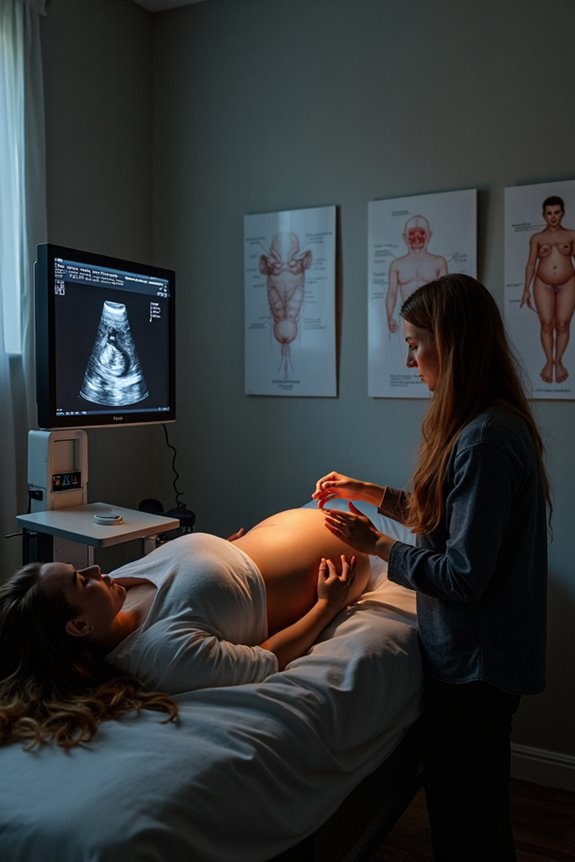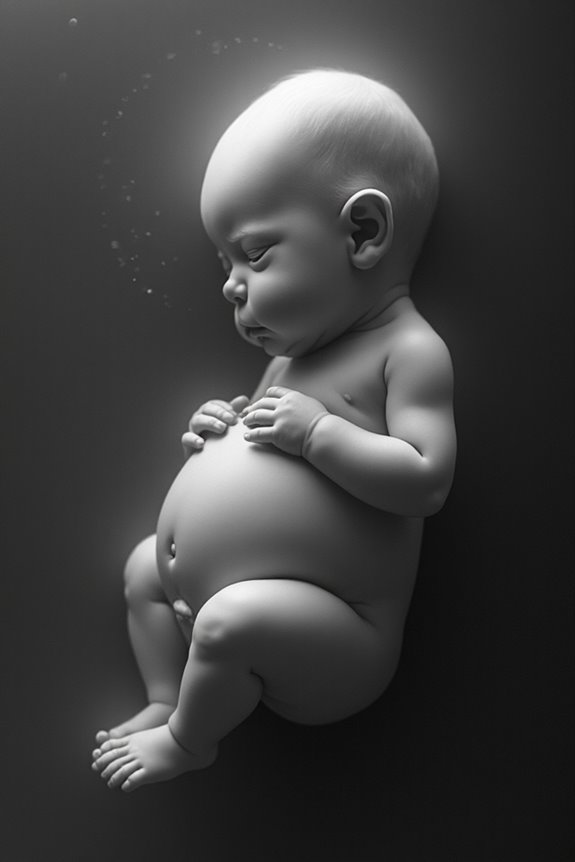We often wonder when babies typically turn head down before birth. Most settle into this ideal position, known as vertex presentation, between 33 and 36 weeks of pregnancy. It helps them navigate the birth canal more easily, facilitating smoother delivery. Sometimes, healthcare providers suggest techniques like pelvic tilts, or medical interventions such as External Cephalic Version (ECV), if needed. These methods are designed to encourage the baby head down, preparing you for different possibilities in the upcoming weeks.
Key Takeaways
- Babies typically turn head down between 33 and 36 weeks of pregnancy.
- Most babies naturally move into the vertex position by the third trimester.
- Head-down position minimizes complications and allows for easier delivery.
- Healthcare providers use ultrasounds to confirm the baby’s position.
- Techniques like pelvic tilts and walking can encourage head-down positioning.
Understanding the Head-Down Position
How do we make sense of the head-down position in preparation for birth? It’s fascinating how babies instinctively move into this optimal position. Known as the vertex or cephalic presentation, it aligns perfectly with the birth canal, easing delivery.
To encourage this, we can explore fetal positioning techniques, ensuring maternal comfort. Here’s what we can do:
- Pelvic Tilts: Gently rocking back and forth can help the baby settle head down.
- Walking: Movement encourages baby’s alignment with gravity.
- Resting Positions: Lying on our side can create space for baby to move.
The head-down position minimizes complications, allowing for more natural deliveries. As we navigate these final months, let’s embrace this journey with knowledge, seeking guidance from healthcare providers and utilizing ultrasounds for confirmation.
General Timeline for Baby’s Movement

As we journey through pregnancy, understanding the general timeline for a baby’s movement can help us feel more connected and informed. In the early pregnancy stages, fetal movements begin around week 12, but we usually don’t feel them right away. By week 16, we might start noticing those tiny, butterfly-like flutters, often missed or mistaken for gas. Around week 20, these movements become more pronounced, known as quickening. As weeks progress, the frequency of movements increases, and by week 24, we can feel kicks, jabs, and even little twitches from baby hiccups. During the third trimester, daily movements become a comforting routine. These sensations, whether rolling or twitching, reassure us of our baby’s development and health.
Signs Indicating Baby Is Head Down

Identifying when a baby turns head down before birth is an important aspect of pregnancy, helping us prepare for the delivery. There are several head down signs we can look for:
- Feeling Baby’s Head: You might notice lower abdominal pressure as the baby’s head settles down.
- Feeling Baby’s Bottom: A soft sensation with small bones, suggesting the baby isn’t breech.
- Movement Changes: Kicks may be felt lower in the abdomen, indicating the baby’s descent.
These changes in baby movements can also bring increased pressure on the pelvic area. Additionally, you might feel a firm, smooth sensation on the abdomen, marking the baby’s back. Regular check-ups with healthcare providers can confirm these observations using techniques like Leopold’s Maneuvers or professional ultrasounds.
Importance of Vertex Presentation

Recognizing the signs of a baby turning head down sets the stage for understanding the importance of vertex presentation in childbirth. This position is crucial for vaginal delivery, as it allows the baby’s head to be the first part to navigate through the birth canal. Most babies naturally move into this position between 33 and 36 weeks of gestation.
- Vertex Significance:
- Ensures multiple delivery options, enhancing delivery outcomes.
- Reduces the need for interventions like cesarean sections.
- Facilitates a smoother passage through the birth canal.
- Types of Vertex Presentation:
- Occiput presentation is the most common.
- Proper head flexion is vital for a successful vaginal delivery.
When the baby is head down, it can significantly reduce the anxiety parents might feel about the delivery process.
How Healthcare Providers Assess Baby’s Position

When it comes to assessing a baby’s position before birth, healthcare providers use a mix of techniques to ensure everything’s on track for a safe delivery. Let’s explore these methods together. Ultrasound techniques, like transabdominal sonography, are key in fetal assessment. They provide clear, real-time images, letting us see exactly how your baby’s positioned. This non-invasive method is accurate and safe, enabling us to monitor any changes over time.
We also employ clinical methods, such as the Leopold maneuvers, to palpate the abdomen and gauge fetal position. During labor, cervical examinations help determine the fetal station, vital for understanding the baby’s descent. With these tools and techniques, we’re committed to optimizing outcomes and ensuring both you and your baby are safe.
Statistics on Babies Moving Head Down

As we’ve just explored how healthcare providers assess a baby’s position before birth, let’s now take a look at some statistics about when babies typically move into the head-down position. By term, around 97% of babies settle into this ideal position, according to head down statistics, which maximizes chances for a smooth delivery. Here’s what we know:
- Timing: Babies often transition head down between 20 and 39 weeks of gestation.
- Breech Prevalence: About 3% to 4% of babies remain breech by term, indicating they haven’t turned head down.
- Early Transition: By 28 weeks, 75% of babies are head down, and by 36 weeks, almost all have turned.
Understanding these patterns can help you prepare and know what to expect as your due date approaches.
Factors Influencing Baby’s Position

Understanding the factors that influence a baby’s position before birth is crucial for expecting parents. Let’s explore how various elements contribute to the fetal position.
- Maternal Factors: Our bodies play a significant role. Maternal size, uterine malformations, and previous pregnancies can affect how much space the baby has for fetal movement.
- Fetal Factors: Babies have their own ways of moving. Their head flexion, attitude, and lie impact positioning.
- Environmental Influences: Our lifestyle choices, like posture and exercise, can shape the womb environment. A nutritious diet supports fetal development, indirectly affecting position.
- External Supports: Using pillows or positional devices can aid in achieving the ideal head-down position, promoting a smoother birth experience.
These insights help us understand the complex dance inside the womb.
What to Expect in the Third Trimester

Entering the third trimester is an exciting and sometimes challenging stage of pregnancy, filled with noticeable changes for both you and the baby. As we approach the final stretch, the baby’s rapid fetal growth becomes more apparent. Their organs mature, and they often settle into a head-down position by week 32, preparing for birth. You’ll likely experience increased maternal discomfort, including back pain, breathlessness, and sleep difficulties. It’s important to attend more frequent prenatal visits to monitor both your health and the baby’s development.
In this phase, we should be vigilant about potential health risks like preeclampsia. The Group B strep test around week 36 ensures both you and your baby are healthy. Staying informed and prepared helps ease this transformative journey.
Medical Interventions for Breech Position

While it might seem daunting, understanding the medical interventions available for a breech baby can help us feel more prepared. We have a couple of breech intervention options to consider. One is the External Cephalic Version (ECV), where a skilled provider applies pressure to our abdomen to turn the baby head-down. This is usually done between 37 and 40 weeks, under continuous monitoring to ensure safety. Though successful, it can cause discomfort and rare complications like premature labor.
If ECV isn’t suitable, we may opt for a C-section. Scheduled around 39 weeks, it minimizes breech vaginal delivery risks but has its own cesarean delivery risks, including longer recovery. Ultrasound confirms the baby’s position beforehand, ensuring informed decisions.
Frequently Asked Questions
Can Maternal Exercise Influence the Baby’s Position?
We might wonder if maternal exercise affects the baby’s position. Engaging in prenatal yoga can enhance pelvic alignment, potentially aiding fetal positioning. Let’s cherish our journey by embracing gentle movements and nurturing our bodies together.
Do Certain Sleeping Positions Help the Baby Turn Head Down?
Let’s explore sleeping techniques together. Optimal postures, like sleeping on our side, especially the left, can aid in fetal movement. Though not guaranteed, these positions might help guide our baby into a head-down position naturally.
Is There a Specific Diet to Promote Head-Down Positioning?
Did you know 25% of babies are breech at 28 weeks? While there aren’t specific dietary guidelines for head-down positioning, let’s focus on nutritional benefits to support overall health, giving our little one the best start.
Can Stress Affect When the Baby Turns Head Down?
We understand your concern about stress impact on fetal positioning. While there’s no direct link, managing stress promotes overall pregnancy health. Let’s prioritize well-being, and consult healthcare providers for guidance on your baby’s position. We’re here together.
Are There Any Cultural Practices for Encouraging Head-Down Position?
They say, “Old habits die hard.” While there aren’t widespread cultural practices, some explore maternity yoga and traditional rituals. Let’s remember, though, always consult with your healthcare provider before trying anything new during this beautiful journey.





